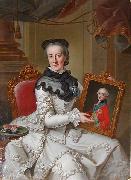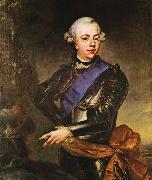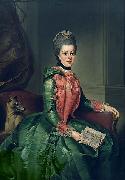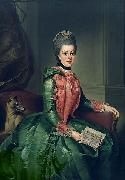Johann Georg Ziesenis El petróleo que Pinta la ReproducciónAll Johann Georg Ziesenis Oil Paintings(b Copenhagen, 1716; d Hannover, 4 March 1776). German painter of Danish birth. He trained with his father, Johann Georg Ziesenis (1681-1748); he became a German citizen in 1743 and subsequently was appointed court painter to Herzog Christian von Pfalz-Zweibrecken in Zweibrecken and, later, Mannheim. In the early 1750s he overcame his technical shortcomings by studying Flemish art, particularly the work of Rubens and van Dyck. He also introduced a new genre, the private court portrait. His portrait of Karl Philipp Theodor, Kurferst von der Pfalz (1757; Munich, Alte Pin.) is original in its intimate view of a nobleman posed at leisure in casual dress, seated in his private study. |
|||

|
|||
|
|
|||
|
||||||||
| Johann Georg Ziesenis (b Copenhagen, 1716; d Hannover, 4 March 1776). German painter of Danish birth. He trained with his father, Johann Georg Ziesenis (1681-1748); he became a German citizen in 1743 and subsequently was appointed court painter to Herzog Christian von Pfalz-Zweibrecken in Zweibrecken and, later, Mannheim. In the early 1750s he overcame his technical shortcomings by studying Flemish art, particularly the work of Rubens and van Dyck. He also introduced a new genre, the private court portrait. His portrait of Karl Philipp Theodor, Kurferst von der Pfalz (1757; Munich, Alte Pin.) is original in its intimate view of a nobleman posed at leisure in casual dress, seated in his private study. |
||||||||
|
|
||||||||
| Pintura identificación:: 77517 Enkedronning Juliane Marie Date 1766-1767 Medium Oil cyf |
||||||||
|
|
||||||||
| Pintura identificación:: 78143 State Portrait of Prince William V of Orange Date 18th century (before 1776) Medium Oil on canvas Dimensions 113 x 91 cm (44.5 x 35.8 in) cyf |
||||||||
|
|
||||||||
| Pintura identificación:: 79027 Portrait of Princess Frederika Sophia Wilhelmina 1768-1769 Oil on canvas 140 x 101 cm (55.1 x 39.8 in) cjr |
||||||||
|
|
||||||||
| Pintura identificación:: 80059 Portrait of Friedrich Ferdinand von Sachsen-Weimar-Eisenach ca. 1776(1776) cjr |
||||||||
|
|
||||||||
| Pintura identificación:: 81991 Portrait of Princess Frederika Sophia Wilhelmina Oil on canvas Dimensions 140 x 101 cm (55.1 x 39.8 in) cyf |
||||||||
|
|
||||||||
| ARTISTA PREVIO PROXIMO ARTISTA | ||||||||
|
|
||||||||
|
Johann Georg Ziesenis (b Copenhagen, 1716; d Hannover, 4 March 1776). German painter of Danish birth. He trained with his father, Johann Georg Ziesenis (1681-1748); he became a German citizen in 1743 and subsequently was appointed court painter to Herzog Christian von Pfalz-Zweibrecken in Zweibrecken and, later, Mannheim. In the early 1750s he overcame his technical shortcomings by studying Flemish art, particularly the work of Rubens and van Dyck. He also introduced a new genre, the private court portrait. His portrait of Karl Philipp Theodor, Kurferst von der Pfalz (1757; Munich, Alte Pin.) is original in its intimate view of a nobleman posed at leisure in casual dress, seated in his private study. |
||||||||
|
|
||||||||
|
CONTACTE EEUU |










